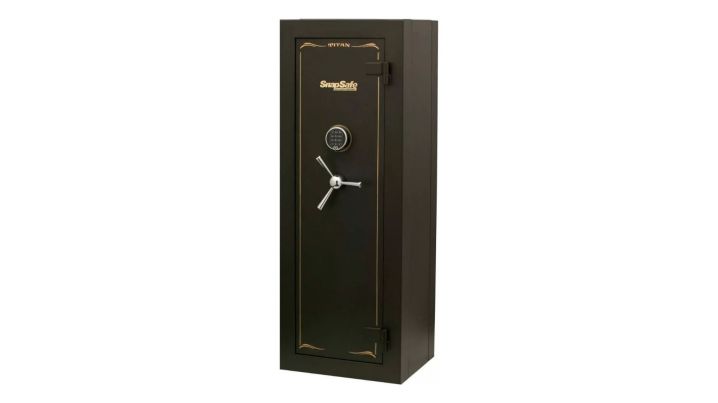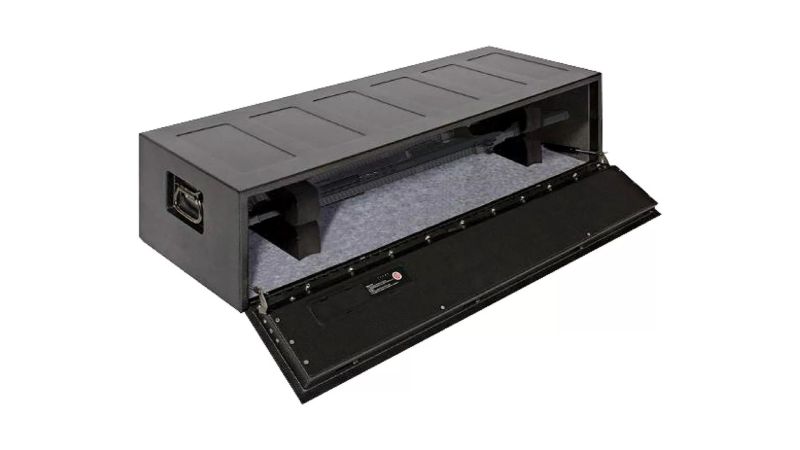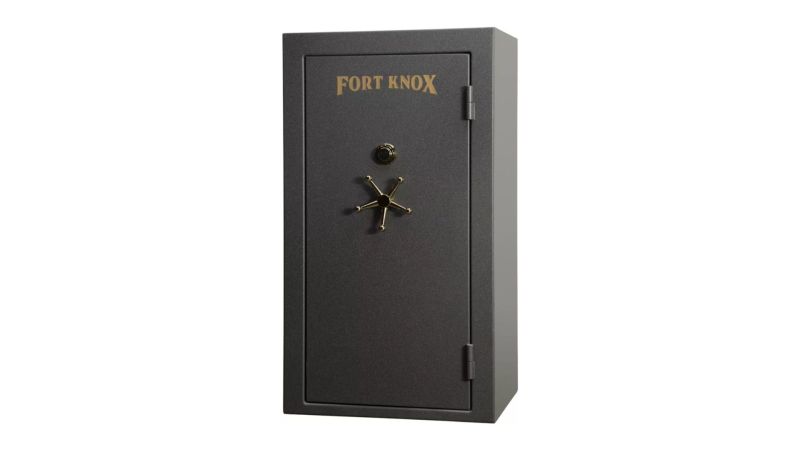We may earn revenue from the products available on this page and participate in affiliate programs.

Safes are a must-have for gun owners. A safe keeps firearms secure and protected from curious children and would-be thieves, and some even protect guns and other valuables from disasters such as house fires. That said, not everyone has the space for a 24-gun safe with a two-by-three-foot footprint, and weighs 750 pounds. Additionally, a large gun safe is visually loud and expressive as to its contents, which may lead to questions, and presents a large target.
Closet gun safes provide a more compact alternative, keeping firearms, documents, and valuables tucked away with your extra shoes and the odd spider. Smaller and lighter in weight, these are perfect for those in townhomes and apartments, as well as folks that just don’t need a steel behemoth in their basement. When properly secured, you maintain the advantage and peace of mind that comes from knowing that your firearms are safely stowed and hidden at the back of the closet alongside your favorite hat and that sweater grandma got you last year for Christmas.
- Best Overall: SnapSafe Titan
- Best Value: Steelwater Heavy Duty 16 Gun Safe
- Honorable Mention: Hornady Rapid Safe AR Locker
- Best Biometric: Barska AX11652
- Best Compact: Surelock Security Concealed 4 Gun Safe
- Best Heavy-Duty: Fort Knox Maverick 6024
- Best Modular: SecureIt Answer Lightweight 52 Pro 8
Methodology
For closet gun safes, we looked for options that maintain the security of your valuables, while also keeping down on size and weight. Given that I currently live in an apartment, researching a topic like this means looking for the kind of product that I myself would use. To that end, I pored over technical data to find the best options possible.
When I looked for gun safes, I used acceptable standards created by California’s Department of Justice for guidance. The standards cover things like the locking mechanism, boltwork, construction, and hinges. Plus, it must meet Underwriters Laboratories standards, which cover things like fireproof ratings.
Typically, we would purchase the items ourselves. However, even closet-sized gun safes are bulky by nature, so we relied on reviews from end users to gather enough information to make the final decisions. Specifically, information from Mr. Safe House, The Truth About Guns, and Strong Gun Safes were critical to picking the best products. For more information on how we at Task & Purpose review products, please view our review guidelines.
Best Overall
SnapSafe Titan
Best Value
Steelwater Heavy Duty 16 Gun Safe
Honorable Mention
Hornady Rapid Safe AR Locker
Best Biometric
Barska AX11652
Best Compact
Surelock Security Concealed 4 Gun Safe
Best Heavy-Duty
Fort Knox Maverick 6024
Best Modular
SecureIt Answer Lightweight 52 Pro 8
Our verdict on closet gun safes
A closet gun safe needs to be light enough to be easily moved, while strong enough to properly secure your valuables. The SnapSafe Titan allows for strength while being easy to assemble and place, while the Steelwater HD 16-Gun Safe provides the best bang for your buck while providing excellent security. Either of these options would be an excellent pick for your closet safe.
What to consider when buying a closet gun safe
There are a few key factors that need to be considered when choosing a safe. Security, price, and size are all main concerns for buyers. Additionally, things like fire safety rating and entry method should be thought of prior to purchase. Consider your needs as well as your environment to make the best purchase decision.
Key features of closet gun safes
Secure design
Security should be the priority when selecting a safe. After all, the main feature of a safe is that it is, of course, safe. To that end, there are a few factors that contribute to how secure a safe is.
How thick is the steel? Steel is measured by thickness in gauge. Similar to a shotgun, the smaller the number, the bigger (or in this case, thicker) it is. Per the California DOJ, the minimum thickness should be 12-gauge steel. Obviously, thicker is better. However, the thicker the steel, the heavier the safe.
Also consider the locking mechanism. Many locks offer a key entry as a backup. However, these can be picked and should be considered cautiously. Ideally, if the safe features key entry, it should be hidden behind the keypad inside the battery compartment. Also, if the lock is electronic, it MUST have a non-volatile memory, meaning that when the batteries die or are removed, it retains the entry code and doesn’t reset to the factory code.
Fire rating
Fire protection is one advantage offered by most safes, including many listed in this article. Fire protection is typically offered in one of two ways. The first uses fireboard, a material similar to drywall. Fireboard carries a layer of moisture within itself. When heated, the moisture is released into the safe, creating steam, cooling the safe and the contents within. The alternative to a fireboard are insulators. Insulators work to prevent heat from entering in the first place.
Additionally, most fire-resistant safes have heat seals on the doors. Just like fire caulk (which should be used to insulate holes drilled for power cords), these seals expand when exposed to heat. This stops hot air and smoke from entering the safe through the door gaps and prevents smoke damage.
The typical base rating for fire protection is 1,200 degrees Fahrenheit for 30 minutes. Testing typically occurs by placing the safe inside a furnace, and is heated to the test temperature and held until the interior of the safe reaches 350 degrees Fahrenheit. To learn more about fire resistance testing, see this piece from DeanSafe.
Size
When a safe manufacturer gives the maximum number of firearms that can be stored in its safe, they’re typically being overly optimistic. By that, I mean that they’re giving a number based on placing slim guns like shotguns and bolt-action rifles inside without optics. Take the number given with a grain of salt and drop the number just a bit.
Pricing for closet gun safes
Budget
Priced below $1,000, you’ll find two types of safes in this range. These safes are typically either made with thin cheap metal and poor design, or are of decent quality but small in size and short on features. While they will do in a pinch, it’s worth considering saving a little longer to be able to purchase a higher-end safe.
Mid-range
Sitting between $1,000 and $2,000, this is the price range where most of the options can be found. With quality steel and decent lock design, the safes in this price range often have features such as fire ratings, are approved by the DOJ, and are big enough to store your collection without bankrupting yourself.
Premium
Spending over $2,000 will get you a safe that is almost certainly impervious to theft and should come with all the features that you can hope for. However, you are reaching the point of diminishing returns, and while your valuables will certainly be safe, you honestly could save a little here and use the saved money to purchase something worth stealing.
A note on biometric locks
Biometric entry, typically in the form of a fingerprint reader, has become popular for gun safes. Typically used for small handgun safes, the technology allows for authorized users to quickly access the safe. That said, the tech is rarely seen in full-size gun safes. For some customizable safes, it can be added on or purchased as an aftermarket upgrade. But considering that these typically cost upwards of $250 to add on, and typically have digital and keyed entry, in my opinion biometric locks are a gimmick and not worth spending money on.
Tips and tricks
- Bolt your safe in place. Almost all closet safes come pre-drilled for floor bolts to improve security and to prevent thieves from making off with the whole safe to open at a later time.
- If your safe uses a battery for a digitally controlled lock, keep spare batteries and change them regularly, just like your fire alarm.
- Add LED light strips to your safe. Strips that are motion-sensitive and battery-operated can be found at cheap prices, and make things easy to see, especially in the back corner of your closet.
FAQs about closet gun safes
You’ve got questions. Task & Purpose has answers.
Q: Will a gun safe damage carpeting in my closet?
A: Yes. Over time, heavy objects will cause indentations and flatten the carpet on which they stand. However, things like vacuuming and steaming the carpet, or even placing an ice cube on the carpet, can lift up the crushed fibers and help restore the carpet towards its original state.
Q: Is the closet a good place to put a gun safe?
A: A closet is an excellent place for a gun safe, especially for those living in smaller homes where floor space is at a premium. Placing a safe in a closet keeps the safe out of sight, keeping your firearms or valuables relatively easy to access, while not giving up space in other parts of the home.
Q: What size of gun safe is suitable for my firearm?
A: That is dependent on the type of firearm. Shotguns and hunting rifles are longer than AR-15s and require a taller gun safe, while pistols can fit into safes that are far smaller.
Q: Do gun safes need to be climate-controlled?
A: That depends. If the location where the safe is kept is climate-controlled, the safe will maintain a similar temperature. However, if you live in a location that sees high humidity, then it may present a rusting issue. To combat this, safes may be modified so that power can be run inside the safe. From there, a small dehumidifier can be installed to help prevent mold and rust.









